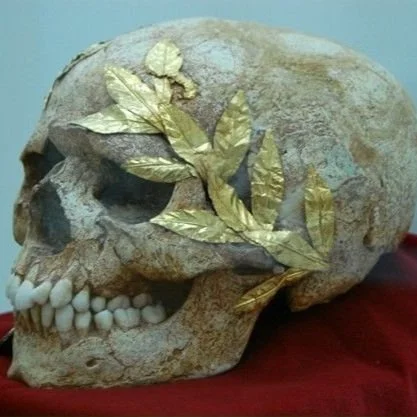A Testament to Ancient Greek Grandeur
The history of Ancient Greece is rich with discoveries that bridge the past and present. Among these, the recent display of a 2,500-year-old skull adorned with a gold wreath stands out as a symbol of both cultural and archaeological marvels. Unearthed in the ancient city of Lato, Crete, this find highlights the sophistication, artistry, and spiritual beliefs of the Dorian civilization.
A Timeless Artifact: The Gold Wreath and Its Significance
The skull of an athlete, preserved with a golden laurel wreath, is a striking reminder of the importance of athleticism and honor in Ancient Greece. The laurel wreath, symbolizing victory and excellence, was often bestowed upon champions in athletic and military contests.
Even after millennia, the wreath remains intact, demonstrating the craftsmanship of the era. Within the skull’s mouth, archaeologists discovered a silver coin—an offering to Charon, the ferryman of Hades. This practice underscores the deeply spiritual connection the Greeks had with death and the afterlife, adhering to rituals that ensured safe passage for the deceased's soul.
Lato: The City of the Goddess Leto
The skull was uncovered in Lato, an ancient Dorian city-state nestled among the olive groves of Crete. Built between two peaks overlooking Mirabello Bay, Lato’s ruins still echo the ingenuity of its builders.
The city was named after the goddess Leto, whose Doric name is Lato. She was a figure of reverence, linked to myths surrounding her children, Apollo and Artemis. Lato thrived during the Dorian period (5th and 4th centuries BCE) but met its decline around 200 BCE. However, its port, Lato pros Kamara, remained active during Roman rule, leaving an enduring legacy of trade and culture.
The Archaeological Museum of Agios Nikolaos: Preserving Greece's Heritage
Today, this golden wreath and skull are exhibited at the Archaeological Museum of Agios Nikolaos, one of Crete's most esteemed institutions. Opened in 1969, the museum houses treasures spanning from the pre-Minoan to Roman periods.
Highlights of the museum include artifacts from the Minoan cemetery of Agia Fotia, intricate terracotta figurines, golden pins, and stone vessels that speak of a sophisticated society deeply connected to art and religion. The skull and its golden adornment are among the museum's most remarkable exhibits, attracting scholars and tourists alike.
The Legacy of Nearchus and Lato’s Historic Importance
Lato's significance extends beyond its archaeological finds. The city was home to Nearchus, a famed admiral of Alexander the Great. His legacy intertwines with Lato’s history, showcasing its influence in shaping notable figures of the ancient world.
Why This Discovery Matters Today
This skull and gold wreath remind us of Ancient Greece's enduring influence on modern civilization. They symbolize the Greek ideals of excellence, spirituality, and artistry that continue to inspire generations.
For those fascinated by Ancient Greece, this discovery is a beacon of cultural pride, demonstrating the rich history and ingenuity of the Hellenic people. As visitors marvel at this exhibit in Crete, they not only witness a relic of the past but also connect with the timeless spirit of Greece.
---
Want More Stories Like This?
Explore Greece’s ancient wonders, modern achievements, and timeless traditions by following our blog. Dive into the world of Hellenic heritage, where every discovery tells a story worth sharing.












